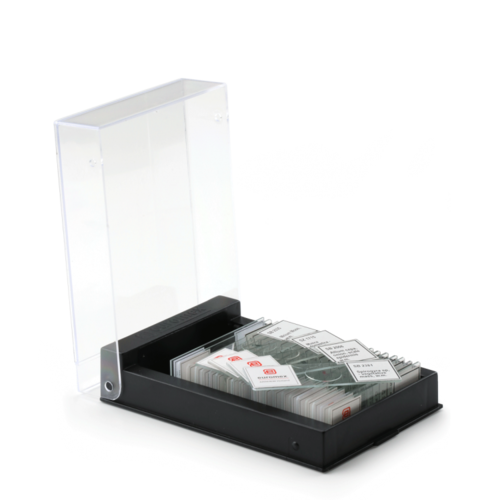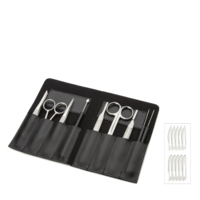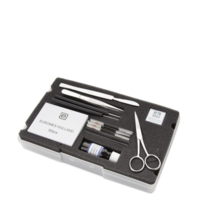You have no items in your shopping cart
Prepared slides set (hobby)
- Buy 2 and save 5%
Euromex offers both teachers, students and microscopy amateurs a wide range of quality microslides, which can be used immediately in biology classes as introduction to zoology and botany
10 or 25 Slides sets of zoology and botany
(for hobby)
Set with 10 (PB.5204) or 25 (PB.5218) microscopy prepared slides for hobby: zoology and botany. Each set contains a variety of prepared slides (see 'Specification'). All microscope slides supplied in a plastic box with transparant cover for 25 slides.
Highlights
- 10 or 25-PC Prepared slides set
- High quality microscope slides
- Zoology and botany
- Set for hobby
| MODELS | Slide set for | Human histology | Mammal histology | Zoology | Botany | Number of slides | Supplied in | |
| PB.5204 | hobby | • | • | 10 | plastic box | |||
| PB.5218 | hobby | • | • | • | • | 25 | plastic box |
$$$$$
How Are Cells Stained and Slides Prepared?
Cell staining techniques and preparation depend on the type of stain and analysis used. One or more of the following procedures may be required to prepare a sample:
• Fixation - serves to "fix" or preserve cell or tissue morphology through the preparation process. This process may involve several steps, but most fixation procedures involve adding a chemical fixative that creates chemical bonds between proteins to increase their rigidity. Common fixatives include formaldehyde, ethanol, methanol, and/or picric acid.
• Mounting - involves attaching samples to a glass microscope slide for observation and analysis. Cells may either be grown directly to the slide or loose cells can be applied to a slide using a sterile technique. Thin sections (slices) of material such as tissue may also be applied to a microscope slide for observation.
PB.5204 10 Set of zoology and botany slides (hobby)
The set contains:
ZOOLOGY
SH.1040 Smooth muscle, teased preparation, rabbit, l.s.and c.s.
SH.1110 Lung with injected blood vessels, rabbit, c.s.
SZ.1708 Apis mellifica, honey bee, mouth parts
SZ.1733 Pieres brassicae, cabbage-white butterfly, part of wing
SZ.1877 Rana sp, frog, blood smear
SB.2015 Ranunculus, buttercup, root, c.s.
BOTANY
SB.2160 Lilium, lily leaf, c.s.
SB.2222 Capsella, shepherds’ purse, ovary w. embryo in cotyledon stadium, l.s.
SB.2374 Aspergillus, brown mold, w.m.
SB.2384 Volvox sp., w.m.
–––––––––––––––––––––––––––––––––––––––––––––––––––––––––
Used abbreviations:
c.s. = cross section
l.s. = longitudinal section
w.m. = whole mount
–––––––––––––––––––––––––––––––––––––––––––––––––––––––––
PB.5218 25 Set of zoology and botany slides (hobby)
The set contains:
HISTOLOGY OF HUMAN AND MAMMALS
SH.1072 Skin section through hair follicle, human
SH.1150 Blood smear human, Giemsa stained
SH.1415 Motor nerve cells with end plates, rabbit w.m.
SH.1470 Taste buds, rabbit, l.s.
BOTANY
SB.2009 Allium cepa, onion, mitosis root tip, l.s.
SB.2055 Zea mays, corn, stem, cs.
SB.2075 Tilia, lime tree, one year stem, c.s.
SB.2100 Pelargonium hortorum, geranium, stem c.s.
SB.2112 Cucurbita, pumpkin, stem, c.s.
SB.2130 Helianthus, sunflower, leaf, c.s.
SB.2135 Nerium oleander, leaf with sunken stomata, c.s.
SB.2210 Lilium, lily, anther with mature pollen, c.s.
SB.2225 Zea mays, corn, corn seed with embryo, l.s
ZOOLOGY
SZ.1520 Paramecium, w.m.
SZ.1535 Euglena virides, a flagellate with eyespot
SZ.1580 Hydra with bud, w.m.
SZ.1630 Taenia, tapeworm pig, mature proglottid, w.m.
SZ.1635 Ascaris megalocephala, horse roundworm, female and male, c.s.
SZ.1640 Lumbricus, earthworm, c.s.
SZ.1655 Daphnia sp., water flea, w.m.
SZ.1705 Apis mellifica, honey bee, posterior leg, w.m.
SZ.1710 Apis mellifica, honey bee compound eye, c.s.
SZ.1719 Musca domestica, house fly, wing w.m.
SZ.1722 Culex pipiens, house mosquito, female, mouth parts
SZ.1724 Fruitfly, drosophila, giant chromosomes of salivary gland, w.m.
–––––––––––––––––––––––––––––––––––––––––––––––––––––––––
Used abbreviations:
c.s. = cross section
l.s. = longitudinal section
w.m. = whole mount
–––––––––––––––––––––––––––––––––––––––––––––––––––––––––











